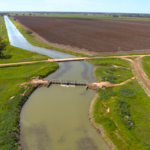The Coleambally irrigation area is situated about 250 miles north of Melbourne in the Riverina area of New South Wales, Australia. The town of Coleambally was established in 1968 by the New South Wales government for the sole purpose of supporting those who were first encouraged to establish irrigated agriculture in the area. Today, the town is home to Australia’s fourth-largest irrigation company, Coleambally Irrigation. The organizational structure of Coleambally Irrigation is different from other irrigation corporations because of its two cooperatives: Coleambally Irrigation Co-operative Limited (CICL) and Coleambally Irrigation Mutual Co-operative Limited (CIMCL). Each cooperative has a separate board, and one of the strengths of the model is that it separates the responsibility for day-to-day operations from the responsibility for future asset refurbishment and replacement.
 CICL is focused on managing and maintaining its gravity irrigation supply and drainage system and provides corporate services. It is not an overstatement to say that CICL is devoted to providing excellent service to its farmers. In fact, CICL is wholly farmer owned. Being a farmer-owned cooperative ensures that the owners and operators of the 491 farms within the irrigation area have their concerns heard and their needs met.
CICL is focused on managing and maintaining its gravity irrigation supply and drainage system and provides corporate services. It is not an overstatement to say that CICL is devoted to providing excellent service to its farmers. In fact, CICL is wholly farmer owned. Being a farmer-owned cooperative ensures that the owners and operators of the 491 farms within the irrigation area have their concerns heard and their needs met.
Managing an irrigation cooperative covering over 1,128 million acres, of which 195,000 acres are intensively irrigated; 321 miles of supply channels; and 456 miles of drainage channels can be mind-boggling. Precision is key, and a constant drive for innovative water management ideas is imperative.
Crops such as rice, cotton, corn, soybeans, wheat, barley, and canola are grown in the area CICL serves. Each crop has its own water needs, and irrigators require a strict water order and control system.
To ensure that every drop of water is going to the right location in a timely manner and is efficiently used, CICL implemented a total channel control (TCC) system. The system allows CICL to execute a farmer’s water orders within a matter of 2 hours. During the fulfillment process, human interaction is not needed. The TCC system precisely regulates water flow and measurements while keeping control of water orders and accounting.
CIMCL was created in January 2000 as a separate cooperative and is responsible for ensuring that there are sufficient funds to maintain the major infrastructure assets. The infrastructure consists of channels, drains, bridges, culverts, regulators, pipes, and meters with varying life expectancies of 20–100 years.
CIMCL has asked all members to pay an annual asset levy per delivery entitlement to fund the future replacement of the irrigation infrastructure. A typical farm holds 1,400 delivery entitlements and 1,400 water entitlements (one water entitlement equals 0.811 acre-feet). The CIMCL charges do not cover the earthen channels; these are maintained by CICL as part of its annual maintenance program.
Every 5 years, CIMCL completes an independent modern engineering equivalent replacement asset (MEERA) assessment of the irrigation district’s assets, including a forecast of their remaining useful operational lives. The MEERA report, coupled with a reliable funding supply, allows CIMCL to update, fix, and replace infrastructure to ensure that the water delivery system remains on the cutting edge.
By working with their farmers, using leading industry technology to manage water, and implementing a sustainable infrastructure plan, Coleambally Irrigation remains the clever company with clever farmers working in close collaboration with the community and the environment.



